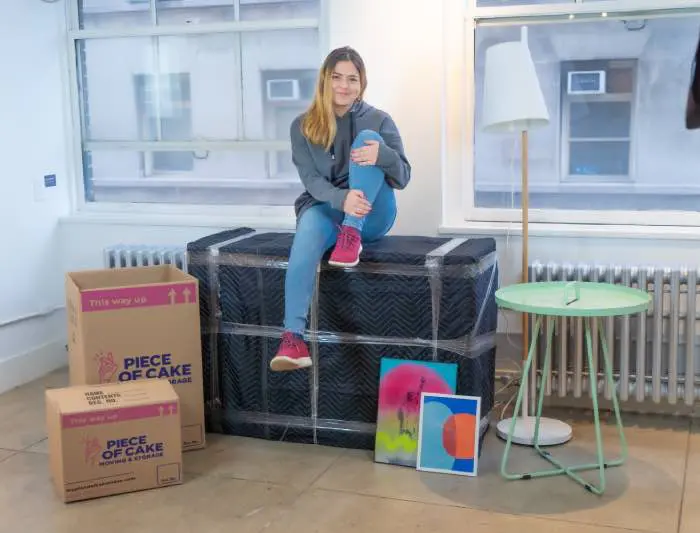How to pack your clothes for moving

Not all movers provide free hanging wardrobes on moving day like us. Even though we do supply a few box wardrobes on the day, you might still have seasonal or casual clothing in a chest of drawers that needs handling. All hanging clothes will be placed in our wardrobe boxes, you will not have to pack them our movers will when they arrive on the day of the move.
Just because your clothes aren’t breakable the way china and glass items are, doesn’t mean some savvy know-how isn’t needed to make sure they arrive in perfect condition. We’ve got your quick guide to packing your clothes for moving in hand below, with all our hints and tips to steer you away from some common mistakes.
Whether you roll or flat fold, the first step is taking the opportunity to clear out those items you don’t wear or need, not just because it’s a perfect opportunity to do a spring clean but because you shouldn’t be paying to move items long overdue for donation or disposal.
Downsize your wardrobe
Those jackets at the back of your wardrobe, the socks full of holes and the shoes you haven’t worn in a decade are all perfect examples of items you aren’t using, or should be replacing soon. Work through your chest of drawers and hanging space first. These will be the areas with your seasonal items and easiest to work through.
For those items in great condition, that are barely worn or even considered ‘corporate wear’ consider donating them (clean and pressed if possible) to a nearby shelter, charity or community organization. We’ve got a guide to some of your best options for donating items and recycling textiles.
Don’t forget clothing in suitcases and boxes
If you live in a small apartment, chances are you put away heavy coats and thick seasonal clothing when spring arrives to clear some space in your wardrobe and put lighter pieces front and centre where they’re easier to find.
Our only caution is to hang onto essential pieces if you don’t have the budget to replace them in time, like winter coats and rain trenches. It’s always better to be out of style than at home with the flu because of a hyper enthusiastic packing process. By all means, move them on, just don’t leave yourself short for an upcoming winter if your budget doesn’t enable you to replace them quickly.
How to manage the ‘toss and store’ piles
Determining which clothing needs to be disposed of is very simple. Charities and community groups won’t take items that are damaged, stained or dirty.
In these cases, leaving those items at textile recycling drop off points like those major retailers provide in exchange for a discount to shop with them, is a great option.
H&M, Madewell, The North Face, Levis, Athleta and Reformation are just some of the retailers with in store recycling bays. New York City’s Department of Sanitation also has a comprehensive, searchable guide of drop off points around the city. Dragging a couple of bags of old clothes a few streets might now seem like a great way to spend your time, but you should get a sense of pride in not contributing to the textile waste epidemic that’s become a big issue for New York.
Of course if all of this is way too much planning and thinking when you’re already overwhelmed with your move, charities that support disadvantaged communities welcome quality donations.
Get set for packing
Now you can see clearly the clothing left to pack, identify any items that need to be washed or repaired and set them aside. You’ll want to clean any remaining items before you finish packing and for those zippers that need replacing.
Set them aside for now and tackle the rest:
- Prep your box after you’ve taped it securely by lining the base with packing paper or plastic to help prevent water damage to your clothes if it rains on moving day. Or pack your clothing in clothing suitcases and bags if you have these.
- Next pack the heaviest items at the base of the box, aim for lighter smaller items to be packed at the top.
- It goes without saying that neatly folded or rolled clothes take up less room than crumpled and unsorted clothing. Whether you roll or fold, the choice is yours. Of course vacuum packing is next level efficient when it comes to preserving space but not everyone has that option.
- Have several boxes open and prepped at the same time so you can group and place items in the appropriate box as you go, such as workwear, casual wear and sweaters.
- Add plastic covers or use slip cases for beaded items to ensure they don’t cause damage if they are pressed too hard against other items and inadvertently catch onto fastenings or embellishments.
- Consider buying a hanging wardrobe for delicate items such as dresses where snags can damage the fabric or worse. Piece of Cake offers these free. Suits and jackets can also be packed in the hanging wardrobe but consider leaving a suit out if you’ll need it just before or just after moving day and can transport it with you so it remains crease free.
- Avoiding loading all your clothes into very large boxes which can make them harder to move and harder to manage at your destination. Try smaller boxes, for example with corporate or workwear in one and sweaters and casual wear such as jeans in another, ensuring they are clearly marked as you go.
- Before you close and seal those boxes do one last check of your local dry cleaner or laundromat and ensure any last minute items sent off for cleaning or repairs aren’t left behind. Don’t pack anything wet as mildew grows fairly quickly and can damage and stain multiple items in transit, not to mention the smell.
What about your shoes?
Some people swear by rolling their socks into their shoes to help them maintain their shape when travelling, others use packing paper or move them in their original boxes. We’ve seen a whole range of approaches, but in the end there is only one hard and fast rule: pack your shoes separately to your clothes.
For reasons of hygiene, cleanliness and the laws of physics (anyone want to see a 6 inch stiletto battle a woollen sweater in transit?) it’s best to just trust us on this one.
By all means, transport them in sturdy, plastic sealable bags if you have the time. Just know flimsy plastic bags can often tear and aren’t a reliable alternative.
Keeping pairs together in shoe bags with some rolled up paper in the toes is a quick and easy way to reduce creases in the leather and make all items easy to track and account for.
Final hints and tips
Of course, depending on how much time you have until moving day, you should also put aside a set of clothes for the day of your relocation and potentially the day before. This suitcase should also contain other items you need on the day such as essential medicine, important documents and phone chargers. Check our moving day guide for a checklist and some more tips.
If some of your clothes will be put into storage or kept in boxes for a while, i.e seasonal clothing, it’s also worth adding some anti insect measures like Cedar Wood Moth Balls or lavender clothing pouches to each box.
Avoid bundling your jewellery in with your clothes. Apart from the potential damage, it’s worth treating your valuables separately and either keeping them in your moving day suitcase or wrapping and protecting the high value items separately.
Although caps can be packed with your sports wear, hats should be packed separately and with a generous amount of paper to help them keep their shape in transit. Soft brimmed hats such as fedoras and panamas can be stacked. We recommend placing them crown down in the base of a lined box, with the brim facing up and providing generous padding to keep them in position. Last but not least, don’t leave any items stored in the drawers and chests as most movers won’t transport them unless they are empty – check with your moving company if you’re hoping to save some time that way.
Ready to make a move? Get in touch today for an obligation-free guaranteed flat price moving quote.
Related articles

Average Moving Cost in Connecticut: Factors that Affect Moving Prices
Learn More

9 Tips for Moving to a Building with no Elevator
Learn More

How to Get Rid of a Couch in 8 Easy Ways
Learn More

Average Moving Costs in NJ: Factors that Affect Moving Prices
Learn More
















